Editor's Pick
Lessons From Haryana and Maharashtra
Praveen Patil
Oct 20, 2014, 12:07 AM | Updated Feb 19, 2016, 06:20 PM IST
Save & read from anywhere!
Bookmark stories for easy access on any device or the Swarajya app.
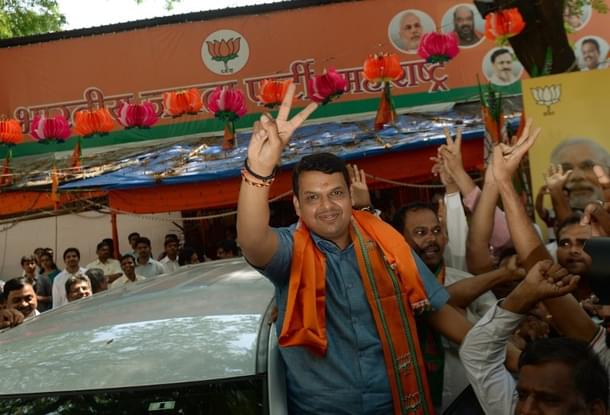
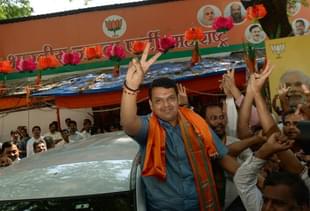
Under Rahul and Sonia Gandhi, the Congress is fast becoming the 21st century version of Muslim League
The year was 1977. Sanjay Gandhi, a poor public speaker at best, was addressing an election rally in Vidisha, Madhya Pradesh during the poll campaign when he suddenly stated that all those who supported JP (Jayaprakash Narayan) were traitors and anti-nationals. He then went on to ask dramatically, “how many of you here are anti-nationals and traitors, please raise your hands?”… Almost the entire audience raised its hands and the hands remained raised till the young Gandhi scion stomped out in anger.
Mrs Indira Gandhi’s love for her supremely talentless son defied all political logic. She pawned not only her own Congress party but also the entire nation just to keep the whimsical Sanjay happy. A great many people within the Congress party and from her own inner circle tried to persuade the then Prime Minister into keeping Sanjay Gandhi away from the election campaign in order to “reduce the losses”, but Indira simply dismissed them and threw them out of her home – among many others, her personal secretary, PN Haskar, her ambassador to the US and chief defender during the Emergency, TN Kaul and fellow freedom movement ‘activist’ Subhadra Joshi where some prime examples who became persona non grata almost overnight for pointing at Sanjay’s follies.

Some four decades, later history is repeating itself as a farce for the hapless Congress party. The new Mrs Gandhi’s love for her son is taking the Congress party towards certain destruction, one step a day.
Post 1977, history was kind to the Congress party and to Indira Gandhi who only found herself out in the wilderness briefly as the JP movement collapsed under the weight of egos. It was only a ‘comma’ in her political life. This time the new Mrs Gandhi and her son seem have encountered a ‘full stop’ in the form of Narendra Modi
Despite the poor 44 seats the Congress won in the summer of 2014, it wasn’t the lowest point in its history. The party managed to get close to 20% of the national vote but had an abysmally low seat conversion ratio due to its widespread base. Congress’s lowest point has come about in this round of elections.
If Congress were to be traded on the stock market, then today is akin to their Lehman Brothers’ moment of 2008; just remember that Lehman Brothers ceased to exist from 2008 after thriving for more than 150 years. By not only losing Haryana and Maharashtra, but finishing third, Congress party is facing grand irrelevance in two of the most prosperous states of India that it had been ruling for a very long time. Beyond the two states of Karnataka and Kerala, Congress party is now virtually reduced to being the party of the Himalayas – or literally in sanyas!
Congress is no longer a viable option for more than 80% of the voters either at the centre or in the states. In fact, given its wholesale reliance on the minority votebank, it would hardly be an exaggeration to suggest that the grand old party is now virtually the Muslim League of 21st Century India!
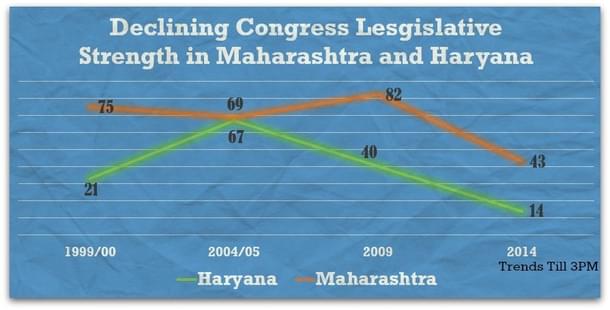
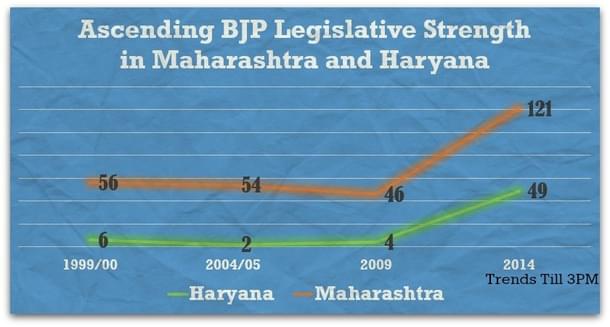
In contrast, the BJP led by Narendra Modi seems to be simply unstoppable at this point of time. At the outset, it is incontrovertible that Prime Minister Modi has been the driving force in both these states almost singlehandedly (as we clearly demonstrated with the ‘Before-After’ survey data last week). Yet, BJP’s failure to convert this huge double-digit vote-share percentage gap into a clear majority in Maharashtra is partly due to lack of organizational strength in various parts of the state. It is now reasonably clear that the party lost more than a dozen seats merely because of lack of cadre and party workers in those assembly segment areas (considering that BJP lacked organizational strength in more than a 100 seats by the time it went to polls, it still is quite an achievement on its own).
Here we must stress our own Pre-poll projections which had almost 97% accuracy rates in terms of vote-share projections. The only jarring note being the under-estimation of NCP, which is a classic case of a small regional party being under-represented in sample surveys. For any pollster, getting a clear picture of differential votes in a massively divided 4 to 5 cornered contest is almost a nightmarish scenario. Yet we almost accurately projected the possible vote-share of different parties within the internationally accepted error margins. Of course, as we had been stressing again and again, converting votes to seats is a dark art in the Indian electoral scene as it simply has no mathematical or statistical foundation to rely upon. Having said that, our seat-share projections were spot-on for Haryana, but we did falter in about 20-30 odd seats in Maharashtra.
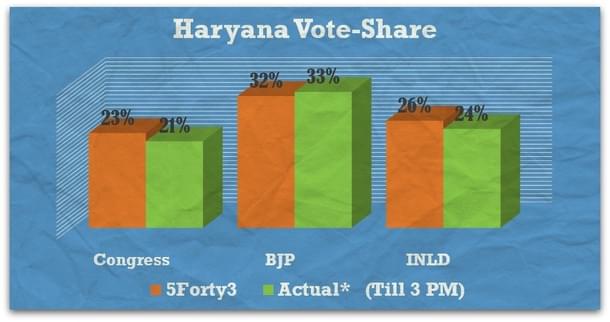
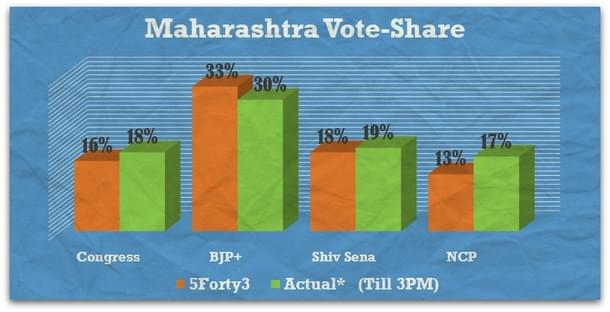
The key takeaway of the results from Haryana and Maharashtra is the whole new social coalition that BJP is building. In the din of “kaun banega Mukhyamantri” hyperbole of TV studio debates, we must not forget that both in Haryana and Maharashtra, for the first time in many decades, a party is emerging victorious (or nearly victorious in the case of Maharashtra) not by wooing the extremely powerful middle castes like Marathas in Maharashtra and Jats in Haryana, but instead by creating a whole new Hindu coalition of upper and lower castes.
The fact that BJP is systematically building an unprecedented coalition of Hindu votes wherein OBCs and Dalits are the biggest stake holders in the Modi agenda of development politics is testimony to BJP’s strategic thinking. In most parts of India, Dalits and OBCs together constitute close to 50% of the total votes and today BJP is undeniably the single biggest beneficiary of these vote blocs.
The uniqueness of this combination (of Dalits and OBCs) is that both the segment of voters are supporting a party without any mutually exclusive agenda, simply because Modi’s development and economic empowerment systems are devoid of such socio-political fault-lines.
One of the primary limitations that confront most regional political parties and even the Congress party of our times, for that matter, is their inherent structural weakness. These are parties which were designed in an erstwhile rural India which once represented the overwhelming majority. The socio-political architecture of all these parties is designed along characteristically feudal lines.
Thus a Shiv Sena caters to sections of Marathas but cannot incorporate vast numbers of working class Biharis or UP-ites. Similarly a Mayawati is a Dalit empress who will not be acceptable to large sections of OBCs. This is where BJP’s strength lies– in being an essentially urban middle-class party. Thus, the party is the fastest to adapt to a new aspirational India where the political/electoral caste fault-lines are disappearing at lightning speed. To that extent, the result in Maharashtra, of not giving BJP a clear mandate, is merely the last barricade of a vote division that may soon become irrelevant.
The other pet theory of the politico-intellectual class of bringing together all the disparate political groups to take-on the BJP could be a much bigger disaster than they anticipate. In fact, this ‘new thinking’ is based on a very outdated theorem floated by the psephological duo of Prannoy Roy and Dorab Soopariwala in the late 80s which they christened as the “Index of Opposition Unity” in order to measure the relative strength of Congress’s performance in winning LS seats. The problem with this hypothesis is that it was devised for a completely different set of political realities in a completely different era.
For example, in Maharashtra, almost 60% of Shiv Sena voters this time were predominantly anti-incumbent and anti-Congress voters, whereas roughly 20-30% of Congress voters were anti-Sena in nature (mostly north Indians). If Shiv-Sena and Congress (and presumably NCP) come together at some point of time, there would be far greater counter mobilization of BJP votes which would then potentially include Upper castes + Dalits + OBC + Middle caste (Marathas) so overwhelmingly that it would then represent a clear spectrum of 75% of voters (instead of 50%) among whom BJP will be the number one choice.
In Up too, where an attempt is being made to bring together improbable allies – Mulayam and Mayawati – in order to defeat the BJP. Such a coalition was at best a partial success during the Ayodhya movement and could end up being a total failure in today’s era of ‘development’ politics.
Mayawati’s great ability is attributed to her vote-bank which is easily transferable to any coalition partner, but it can potentially fail if an alliance with SP is formulated as a vast majority of Dalits suffer the everyday strong arm tactics of Yadavs under the SP regime. If anything, such an alliance will only hasten the process of a near total shift of Dalit votes from BSP to BJP.
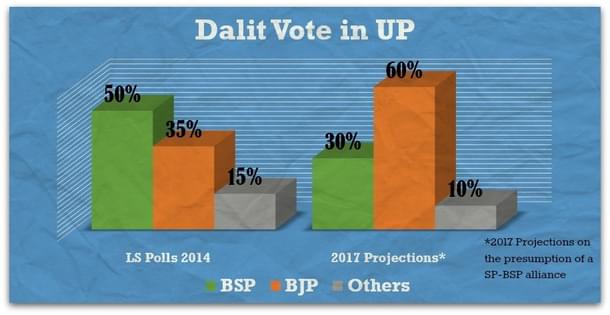
Even in a state like Bihar, the churn in non-Yadav OBC votes in combination with Dalits and upper-castes is happening even as you read this article.
Notwithstanding the recent JDU-RJD success in the by-elections, the real elections, sometime next year, will likely produce a far greater vote condensation into pro-BJP and anti-BJP platform which will only end up helping Modi and his politics. This is in fact quite a simple logic of choice – ordinary people, tend to have a fragmented choice when confronted with multiple options, but will have to naturally gravitate towards one or the other when there are only two choices.
The only real consolidation of votes that may happen in the eventuality of all other opponents banding together would be that of the remaining 20% of the voters. Even this may become a mirage as Muslim-centric parties may start to become the number one choice for many Muslim voters as was evident by MIM’s performance in parts of Maharashtra today. In fact, it can be argued that Muslim-centric-Majlis parties may get emboldened further and try to enter into electoral scene in much greater degree in the heartland in the coming months.
There are also lessons for the BJP and Modi in today’s verdict, especially in Maharashtra. For BJP and Modi to continue to remain a beacon of hope in the Indian polity there has to be an absolutely no-nonsense push towards economic reforms. Modi’s message is essentially that of economic betterment of lives for millions and millions of Indians, but his government is still finding it tough to break out of a deeply entrenched socialist mindset of Dilli. The same old lazy visions of NREGA type empowerment is something that this new India is unlikely to accept. This new India expects a complete breakaway from the old order, nothing less!
No doubt as the Prime Minister, Modi has initiated some systemic changes like connecting the entire populace with the banking network or enticing the nation to adapt a nationwide cleaning drive or even the river cleaning and interlinking vision. All these are historic changes. Yet, these are merely the added bonus from a Modi regime in the end analysis of voter perception.
Interacting with tens of hundreds of voters across India over the last few months, I believe employment, availability of power, and visible economic growth are three important paradigms on which this Modi government has to deliver (more importantly, must also be seen to deliver) in order to continue to remain the number one choice for many Indians.
All the talk of a resurgent Hindutva ideology or about punishing the Gandhi-Vadras or about socialist promises like NREGA may power TV debates, Twitter outrages and even letters from 28 economists, but the ground reality of India changing. It’ all about the economy, stupid!
Analyst of Indian electoral politics and associated economics with a right-of-centre perspective.





